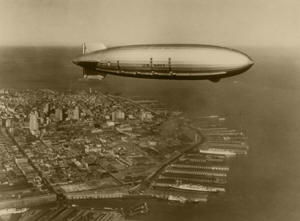 |
|
February 12, 2010
- Commemorating the 75th anniversary of the loss of the U.S. Navy
airship USS Macon, NOAA on Thursday announced that the wreck site on the
seafloor within Monterey Bay National Marine Sanctuary has been added to
the National Register of Historic Places. The
Macon, a 785-foot dirigible was one of the
largest airships in the world – comparable in size to the RMS Titanic.
It was intended to serve as a scout ship for the Pacific Fleet and had
the ability to launch and recover Sparrowhawk biplanes.
In service less than two years, the Macon,
based at Moffett Field in Sunnyvale,
Calif., was damaged in a storm on Feb. 12, 1935, and sank in
the Pacific Ocean off Point Sur, south of
San Francisco. All but two of the
Macon’s 83 crewmen were rescued by nearby Navy
ships. “The
USS Macon and its four associated Sparrowhawk biplanes are not only
historically significant to our nation’s history, but have unique ties
to our local communities, where public museums highlight the airship’s
history,”
|
|
“The National Register listing highlights the importance of protecting
the wreck site and its artifacts for further understanding our past” said
Paul Michel, Monterey Bay National Marine Sanctuary superintendent.
The National
Register of Historic Places is the nation’s official list of cultural
places considered worth preserving. Authorized by the National Historic
Preservation Act of 1966, the Register is part of a national program to
coordinate and support public and private efforts to identify, evaluate
and protect America's
historic and archeological resources. Properties listed in the National
Register can qualify for federal grants for historic preservation.
The wreckage
of the Macon
and four aircraft lie at a depth of more than 1,500 feet and were first
documented in 1990 by the Monterey Bay Aquarium Research Institute
(MBARI). Monterey Bay National Marine Sanctuary conducted a sonar survey
in 2005 followed by the first archaeological expedition in 2006 that
documented the Macon’s remains. The
expedition was a collaborative venture involving NOAA's Office of
National Marine Sanctuaries, NOAA's Office of Ocean Exploration and
Research, NOAA's Preserve America Initiative, MBARI,
Stanford
University,
University of New Hampshire,
U.S.
Navy, Monterey Maritime and
History
Museum, and the Moffett
Field Historical Society and Museum.
|


